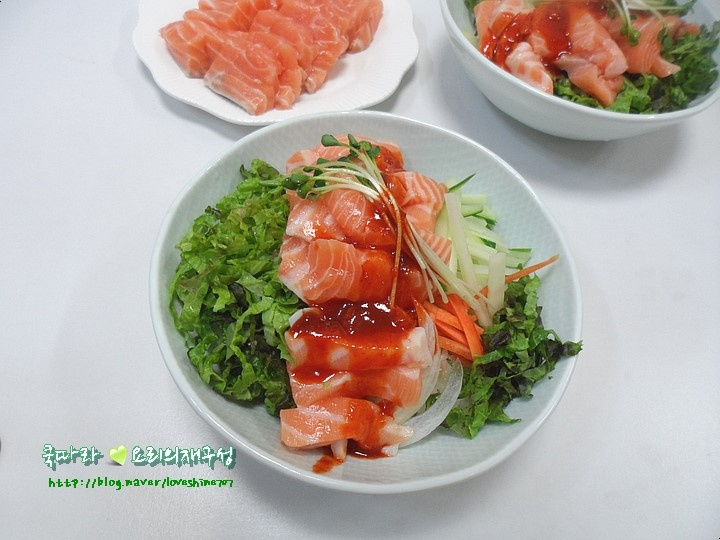Fresh Salmon Bibimbap
Simple No-Cook Summer Superfood: Fresh Salmon Bibimbap Recipe

As the weather warms up, appetites can dwindle, and the thought of complex, time-consuming meals becomes daunting. This is the perfect time to introduce a light yet delicious summer superfood that will awaken your taste buds: Fresh Salmon Bibimbap! This is an incredibly simple bibimbap recipe that requires absolutely no cooking, making it a quick and refreshing meal. Enjoy a vibrant and healthy dish that’s perfect for the summer season!
Main Ingredients- 500g fresh salmon fillet
- 10 large lettuce leaves
- 1/2 cucumber
- 30g onion (about 1/4 medium onion)
- 30g carrot (about 1/4 medium carrot)
- A small handful of fresh sprouts (e.g., radish sprouts)
Spicy & Sweet Gochujang Sauce- 5 Tbsp gochujang (Korean chili paste)
- 1 Tbsp minced garlic
- 5 Tbsp apple cider vinegar (adds a refreshing tang)
- 1 tsp wasabi paste (adjust to your preference)
- 3 Tbsp oligosaccharide or corn syrup (for gloss and sweetness)
- 1 Tbsp brown sugar
- 3 Tbsp maesil cheong (Korean plum extract) (for deep sweetness and aroma)
- 3 Tbsp lemon juice (enhances bright flavor)
- 5 Tbsp gochujang (Korean chili paste)
- 1 Tbsp minced garlic
- 5 Tbsp apple cider vinegar (adds a refreshing tang)
- 1 tsp wasabi paste (adjust to your preference)
- 3 Tbsp oligosaccharide or corn syrup (for gloss and sweetness)
- 1 Tbsp brown sugar
- 3 Tbsp maesil cheong (Korean plum extract) (for deep sweetness and aroma)
- 3 Tbsp lemon juice (enhances bright flavor)
Cooking Instructions
Step 1
Begin by preparing all the fresh ingredients for your bibimbap. Wash the vegetables thoroughly under running water and pat them dry. For the salmon, ensure it’s at its freshest and handle it carefully during preparation.

Step 2
Gently rinse the fresh salmon fillet in lightly salted water. Then, place it on a clean paper towel or a kitchen towel and press down firmly to absorb any excess moisture and oil. This step is crucial for achieving the best texture. Once drained, slice the salmon into bite-sized pieces (about 2-3 cm). This preparation ensures you can savor the pure, fresh flavor of the salmon.

Step 3
Tear the lettuce leaves into bite-sized pieces or shred them finely. Peel the cucumber, carrot, and onion (or wash them thoroughly if you prefer to keep the skin on the cucumber). Cut them all into thin julienne strips. This uniform cutting allows all the ingredients to mix well with the rice and sauce for a harmonious bite.

Step 4
Now, let’s make the gochujang sauce. In a mixing bowl, combine 5 tablespoons of gochujang, 1 tablespoon of minced garlic, 5 tablespoons of apple cider vinegar, 1 teaspoon of wasabi paste, 3 tablespoons of oligosaccharide, 1 tablespoon of brown sugar, 3 tablespoons of maesil cheong, and 3 tablespoons of lemon juice. Whisk everything together with a spoon or whisk until smooth and well combined, ensuring there are no lumps. You can adjust the amount of wasabi according to your spice preference. Taste the sauce and enjoy the perfect balance of savory, sweet, and spicy flavors!

Step 5
Assemble your bibimbap bowl. Start with a base of slightly cooled cooked rice in your serving bowl. Artfully arrange the julienned vegetables and the generous portions of fresh salmon on top of the rice. Finally, add a small garnish of fresh sprouts for a touch of green and a crisp texture. Your visually appealing bibimbap is now ready to be dressed!

Step 6
It’s time to mix and enjoy! Drizzle your prepared spicy and sweet gochujang sauce generously over the bibimbap. Using your spoon, gently mix all the ingredients—the salmon, vegetables, and rice—until everything is well combined with the sauce. Each bite will be a delightful explosion of fresh flavors and satisfying textures. Enjoy your delicious and healthy meal!




